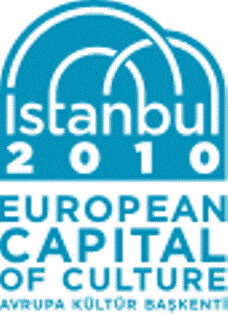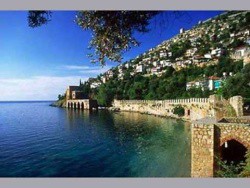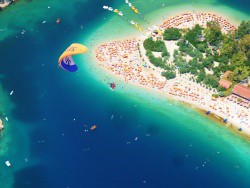Topkapi Palace - Ottoman Empire Palace - Turkey

The Topkapı Palace (Turkish: Topkapı Sarayı)[1] or in Ottoman Turkish: طوپقپو سرايى, usually spelled "Topkapi" in English) is a palace in Istanbul, Turkey, which was the official and primary residence in the city of the Ottoman Sultans for 400 years of their 624-year reign,[2] from 1465 to 1856.
The palace was a setting for state occasions and royal entertainments and is a major tourist attraction today, containing the most holy relics of the Muslim world such as the prophet Muhammed's cloak and sword.[2] Topkapı Palace is among those monuments belonging to the "Historic Areas of Istanbul", which became a UNESCO World Heritage Site in 1985, and is described in Criterion iv as "the best example[s] of ensembles of palaces [...] of the Ottoman period."[3]
Initial construction began in 1459, ordered by Sultan Mehmed II, the conqueror of Byzantine Constantinople. The palace is a complex made up of four main courtyards and many smaller buildings. At the height of its existence as a royal residence, the palace was home to as many as 4,000 people,[2] formerly covering a larger area with a long shoreline. The complex has been expanded over the centuries, with many renovations such as after the 1509 earthquake and 1665 fire. It held mosques, a hospital, bakeries, and a mint.[2] The name directly translates as "Cannon gate Palace", from the palace being named after a nearby, now destroyed, gate.
Topkapı Palace gradually lost its importance at the end of the 17th century, as the Sultans preferred to spend more time in their new palaces along the Bosporus. In 1856, Sultan Abdül Mecid I decided to move the court to the newly built Dolmabahçe Palace, the first European-style palace in the city. Some functions, such as the imperial treasury, the library, mosque and mint, were retained though.
After the end of the Ottoman Empire in 1921, Topkapı Palace was transformed by government decree on April 3, 1924 into a museum of the imperial era. The Topkapı Palace Museum is under the administration of the Ministry of Culture and Tourism. The palace complex has hundreds of rooms and chambers, but only the most important are accessible to the public today. The complex is guarded by officials of the ministry as well as armed guards of the Turkish military. The palace is full of examples of Ottoman architecture and also contains large collections of porcelain, robes, weapons, shields, armor, Ottoman miniatures, Islamic calligraphic manuscripts and murals, as well as a display of Ottoman treasure and jewelry.
MORE
Turkey - Istanbul meets the continents of the world wonders
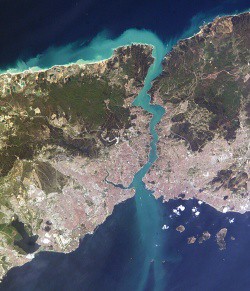
Istanbul (Turkish: İstanbul, historically known as Byzantium and Constantinople;[4] see the names of Istanbul) is the largest city in Turkey and fourth largest city proper in the world with a population of 12.8 million, also making it the second largest metropolitan area in Europe by population, and the largest metropolitan city proper.[1] Istanbul is also a megacity, as well as the cultural, economic, and financial centre of Turkey. The city covers 39 districts of the Istanbul province.[5] It is located on the Bosphorus Strait and encompasses the natural harbour known as the Golden Horn, in the northwest of the country. It extends both on the European (Thrace) and on the Asian (Anatolia) sides of the Bosphorus, and is thereby the only metropolis in the world that is situated on two continents.
In its long history, Istanbul has served as the capital city of the Roman Empire (330–395), the Eastern Roman (Byzantine) Empire (395–1204 and 1261–1453), the Latin Empire (1204–1261), and the Ottoman Empire (1453–1922). The city was chosen as joint European Capital of Culture for 2010. Historic areas of Istanbul were added to the UNESCO World Heritage List in 1985
MORE
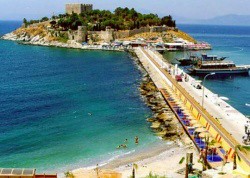
Kuşadası is a resort town on Turkey's Aegean coast[1] and the center of the seaside district of the same name in Aydın Province. Kuşadası lies at a distance of 95 km (59 mi) to the south from the region's largest metropolitan center of İzmir, and 71 km (44 mi) from the provincial seat of Aydın situated inland. Its primary industry is tourism. Her neighbours are Germencik district from northeast, Söke one from southeast, Aegean Sea from west and Selçuk district from north.
MORE

Cappadocia
Cappadocia (pronounced /kæpəˈdoʊʃə/; also Capadocia; Turkish Kapadokya, from Greek: Καππαδοκία / Kappadokía) is a region in central Turkey, largely in Nevşehir Province.
The name was traditionally used in Christian sources throughout history and is still widely used as an international tourism concept to define a region of exceptional natural wonders, in particular characterized by fairy chimneys and a unique historical and cultural heritage. The term, as used in tourism, roughly corresponds to present-day Nevşehir Province.
In the time of Herodotus, the Cappadocians were reported as occupying the whole region from Mount Taurus to the vicinity of the Euxine (Black Sea). Cappadocia, in this sense, was bounded in the south by the chain of the Taurus Mountains that separate it from Cilicia, to the east by the upper Euphrates and the Armenian Highland, to the north by Pontus, and to the west by Lycaonia and eastern Galatia.
MORE
Recent Posts
Labels
- Antalya (4)
- Bergama (1)
- Bodrum (1)
- Cappadocia (1)
- Ephesus (1)
- Hagia Sophia (1)
- Hierapolis (1)
- Istanbul (7)
- Kusadasi (1)
- Pamukkale (2)
- Perge (1)
- Side (1)
- Termessos (1)
- Topkapı Palace (1)
- izmir (4)
B Tube Other Versions
Copyright © B Tube Weblog Template.




